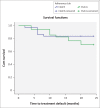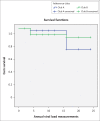'At this [ adherence] club, we are a family now': A realist theory-testing case study of the antiretroviral treatment adherence club, South Africa
- PMID: 31308968
- PMCID: PMC6620516
- DOI: 10.4102/sajhivmed.v20i1.922
'At this [ adherence] club, we are a family now': A realist theory-testing case study of the antiretroviral treatment adherence club, South Africa
Abstract
Background: An estimated 7.9 million people were living with HIV in South Africa in 2017, with 63.3% of them remaining in antiretroviral therapy (ART) care and 62.9% accessing ART. Poor retention in care and suboptimal adherence to ART undermine the successful efforts of initiating people living with HIV on ART. To address these challenges, the antiretroviral adherence club intervention was designed to streamline ART services to 'stable' patients. Nevertheless, it is poorly understood exactly how and why and under what health system conditions the adherence club intervention works.
Objectives: The aim of this study was to test a theory on how and why the adherence club intervention works and in what health system context(s) in a primary healthcare facility in the Western Cape Province.
Method: Within the realist evaluation framework, we applied a confirmatory theory-testing case study approach. Kaplan-Meier descriptions were used to estimate the rates of dropout from the adherence club intervention and virological failure as the principal outcomes of the adherence club intervention. Qualitative interviews and non-participant observations were used to explore the context and identify the mechanisms that perpetuate the observed outcomes or behaviours of the actors. Following the retroduction logic of making inferences, we configured information obtained from quantitative and qualitative approaches using the intervention-context-actor-mechanism-outcome heuristic tool to formulate generative theories.
Results: We confirmed that patients on ART in adherence clubs will continue to adhere to their medication and remain in care because their self-efficacy is improved; they are motivated or are being nudged.
Conclusion: A theory-based understanding provides valuable lessons towards the adaptive implementation of the adherence club intervention.
Keywords: Adherence Club; Antiretroviral Treatment; Medication Adherence; Realist Evaluation; Retention in Care; South Africa.
Conflict of interest statement
The authors declare that they have no financial or personal relationship(s) that may have inappropriately influenced them in writing this article.
Figures




Similar articles
-
A realist approach to eliciting the initial programme theory of the antiretroviral treatment adherence club intervention in the Western Cape Province, South Africa.BMC Med Res Methodol. 2018 May 25;18(1):47. doi: 10.1186/s12874-018-0503-0. BMC Med Res Methodol. 2018. PMID: 29801467 Free PMC article.
-
Unearthing how, why, for whom and under what health system conditions the antiretroviral treatment adherence club intervention in South Africa works: A realist theory refining approach.BMC Health Serv Res. 2018 May 9;18(1):343. doi: 10.1186/s12913-018-3150-6. BMC Health Serv Res. 2018. PMID: 29743067 Free PMC article.
-
Unravelling how and why the Antiretroviral Adherence Club Intervention works (or not) in a public health facility: A realist explanatory theory-building case study.PLoS One. 2019 Jan 16;14(1):e0210565. doi: 10.1371/journal.pone.0210565. eCollection 2019. PLoS One. 2019. PMID: 30650129 Free PMC article.
-
Exploring 'generative mechanisms' of the antiretroviral adherence club intervention using the realist approach: a scoping review of research-based antiretroviral treatment adherence theories.BMC Public Health. 2017 May 4;17(1):385. doi: 10.1186/s12889-017-4322-8. BMC Public Health. 2017. PMID: 28472938 Free PMC article.
-
Initial programme theory for community-based ART delivery for key populations in Benue State, Nigeria: a realist evaluation study.BMC Public Health. 2023 May 12;23(1):870. doi: 10.1186/s12889-023-15774-w. BMC Public Health. 2023. PMID: 37170268 Free PMC article. Review.
Cited by
-
Community Group-Based Models of Medication Delivery: Applicability to Cardiovascular Diseases.Glob Heart. 2021 May 5;16(1):36. doi: 10.5334/gh.763. Glob Heart. 2021. PMID: 34040949 Free PMC article. Review.
-
Patient-centred care: reality or rhetoric-patients' experiences at ARV clinics located in public hospitals in KwaZulu-Natal, South Africa.AIDS Res Ther. 2022 Sep 10;19(1):41. doi: 10.1186/s12981-022-00463-2. AIDS Res Ther. 2022. PMID: 36088340 Free PMC article.
-
Experiences of Older People Living with Human Immunodeficiency Virus Comorbidity Attending Coordinated Healthcare Services.Ann Geriatr Med Res. 2025 Mar;29(1):15-27. doi: 10.4235/agmr.24.0106. Epub 2025 Jan 9. Ann Geriatr Med Res. 2025. PMID: 40195841 Free PMC article.
-
Using Intervention Mapping methodology to design an HIV linkage intervention in a refugee settlement in rural Uganda.AIDS Care. 2022 Apr;34(4):446-458. doi: 10.1080/09540121.2021.1900532. Epub 2021 Mar 21. AIDS Care. 2022. PMID: 33749418 Free PMC article.
-
Factors associated with ART adherence among HIV-positive adherence club members in Ekurhuleni Metropolitan Municipality, South Africa: A cross-sectional study.PLoS One. 2022 Nov 1;17(11):e0277039. doi: 10.1371/journal.pone.0277039. eCollection 2022. PLoS One. 2022. PMID: 36318541 Free PMC article.
References
-
- Human Sciences Research Council South African National HIV prevalence, incidence, behaviour and communication survey, 2017 [homepage on the Internet]. 2018. [cited 2019 Feb 22]. Available from: http://www.hsrc.ac.za/uploads/pageContent/9234/FINALPresentationfor17Jul....
-
- Department of Health Implementation of the universal test and treat strategy for HIV positive patients and differentiated care for stable patients [homepage on the Internet]. Pretoria: Department of Health; 2016. [cited 2018 Oct 15]. Available from: http://www.sahivsoc.org/Files/22%208%2016%20Circular%20UTT%20%20%20Decon....
-
- Shisana O, Rhele T, Simbayi LC, et al. . The Human Sciences Research Council, 2012. 2014.
-
- WHO Consolidated guidelines on the use of antiretroviral drugs for treating and preventing HIV infection: recommendations for a public health approach; 2016 [homepage on the Internet]. Switzerland: WHO; 2016. Available from: http://apps.who.int/iris/bitstream/10665/208825/1/9789241549684_eng.pdf?.... - PubMed
LinkOut - more resources
Full Text Sources
